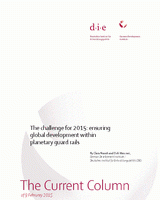The challenge for 2015: ensuring global development within planetary guard rails
Brandi, Clara / Dirk MessnerThe Current Column (2015)
Bonn: German Development Institute / Deutsches Institut für Entwicklungspolitik (DIE) (The Current Column of 9 February 2015)
Bonn, 9 February 2015. 2015 is a key year for global cooperation. The Third International Conference on Financing for Development will be held in Addis Ababa in July. Then the international community plans to agree on Sustainable Development Goals (SDGs) in September to replace the Millennium Development Goals (MDGs), which expire this year. Finally, a global climate agreement is set to be approved in Paris at the end of the year.
The post-2015 agenda is an ambitious project The SDGs are intended to bring all countries around one table to commit themselves to working together for the good of current and future generations at national and global level. The Open Working Group (OWG) of the United Nations (UN) submitted a proposal for 17 SDGs in summer 2014, paving the way for the negotiations currently being conducted between UN Member States. The 17 goals proposed by the Open Working Group represent a list of key priorities for sustainable development. However, there is still insufficient consideration being given to one fundamental element, namely the need to safeguard the stability of the earth system that is essential to the future of humankind.
Far more attention has been given to socio-economic development than to environmental sustainability in recent decades. The patterns of growth that have emerged as a result have put a number of essential earth system services at risk, and with them poverty-reduction gains and the livelihood of future generations.
Consequently, the goal of safeguarding earth system services should be added to the list of SDGs. This additional goal is closely related to the “Planetary Boundaries” framework put forward by Johan Rockström and other researchers, and the highly analogous “guard rail” concept proposed by the German Advisory Council on Global Change (WBGU). Any crossing of the planetary guard rails would put at risk the functioning of the planet and the safe operating space for humankind, thereby posing a threat to the basis for future development. These guard rails do not represent a development restriction for the poor. On the contrary, staying within them is essential to fighting poverty and facilitating human development.
What targets should the planetary guard rail SDG prescribe? As recently proposed by the WBGU, the SDG should set the following targets to tackle environmental challenges: limit the warming of the climate system to 2 °C and prevent the pH level of the uppermost ocean layer falling by more than 0.2 units by stopping global CO2 emissions from fossil energy sources by around 2070; halt human-induced loss of biodiversity and ecosystem services by 2050; stop net land and soil degradation by 2030; eliminate risks from long-lived and harmful anthropogenic substances, such as mercury and plastic waste, by 2050; prevent the loss of non-recoverable phosphorus, an essential resource for agriculture and food security, by 2050.
From a planetary guard rail point of view, the SDGs proposed by the Open Working Group do not go far enough. Just three of the 17 proposals mention environmental changes that are linked to the guard rails. However, SDG 13 on climate change is vaguely worded and makes no reference to the 2 °C guard rail or other workable thresholds. While SDG 14, which relates to oceans, seas and marine resources, mentions ocean acidification, it too fails to identify any workable thresholds for tackling the problem. SDG 15 concerns the protection of terrestrial ecosystems and the conservation of biodiversity. It is relatively broad in its wording yet insufficiently ambitious in scope to ensure that planetary guard rails are observed.
The international community should push for the guard rail concept to be more strongly anchored in the SDGs. While there may be many reasons to avoid undoing the current package of 17 proposed goals, the guard rails can and indeed must be taken into account to a greater extent in the SDGs, both in the preamble and at target and indicator level.
Looking at the post-2015 agenda from the guard rail perspective, it needs to be stressed that the SDGs must be universally applicable to all nations, be they OECD or non-OECD countries. This is the sole means of ensuring that we remain within planetary boundaries. After all, it is the consumption patterns, lifestyles and carbon footprints of the global middle and upper classes that are causing the greatest harm to our planet.
It is therefore essential that the SDGs also apply to countries such as the United States and European Union member states. This is the only way of preserving a safe operating space for humankind, for poverty reduction and for the development of many generations to come.


